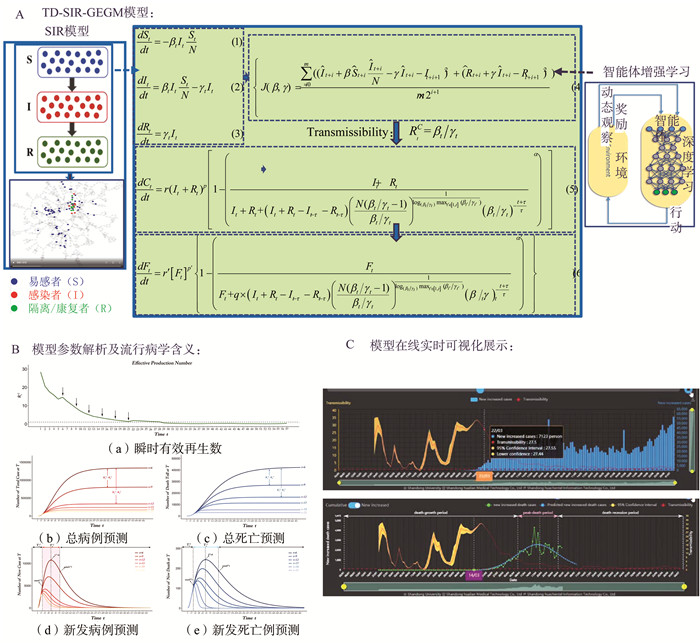-
摘要: 大数据生态流行病学理论范式阐明了一个更全面的生态流行病学视角,承认和捕捉现实世界和虚拟世界中的众多健康决定因素具有等级镶嵌和交互博弈的复杂网络特征。在这种镶嵌分层相互作用及其网络博弈的复杂背景下,传统的基于独立随机假设的传统流行病学抽样调查方法、传统分析流行病学和实验流行病学设计策略及统计分析方法,均面临巨大挑战。取而代之的是,系统动力学模型、网络分析及网络动力学模型、多智能体系统模型以及未来需要发展的生态流行病学超图因果推断模型。从而,由新理论范式、新设计策略和新统计方法,构成了大数据生态流行病学理论方法体系。
-
关键词:
- 生态流行病学 /
- 系统动力学模型 /
- 网络分析及网络动力学模型 /
- 多智能体系统模型 /
- 超图因果推断模型
Abstract: The theoretical paradigm of big data eco-epidemiology illustrates a more comprehensive perspective of eco-epidemiology, acknowledging and capturing the complex network characteristics of hierarchical mosaic and interactive games of many health determinants in the real and virtual worlds. Under the complex background of mosaic layered interaction and network-game, the traditional epidemiological sampling methods based on independent random assumptions, traditional analytical and experimental epidemiological design strategies and statistical analysis methods, all face huge challenges. Furthermore, they could be replaced by system dynamics models, network analysis and network dynamics models, multi-agent system models, and causal inference hypergraph models that need to be developed in the future. Thus, a new theoretical paradigm, new design strategy and new statistical method constitute a theoretical method system of big data eco-epidemiology. -
图 3 多智能体系统及其代理人基模型
注:主体为独立个体或共同群体,交互的对象为虚拟世界和现实世界中的因素(详见图 1)。
Figure 3. Multi-agent system and its agent-based model
-
[1] 薛付忠. 大数据生态流行病学理论模型[J]. 中华疾病控制杂志, 2022, 26(10): 1124-1128. DOI: 10.16462/j.cnki.zhjbkz.2022.10.003.Xue FZ. The theoretical model of big data eco-epidemiology[J]. Chin J Dis Control Prev, 2022, 26(10): 1124-1128. DOI: 10.16462/j.cnki.zhjbkz.2022.10.003. [2] Epstein JM. Generative social science: studies in agent-based computational modeling[J]. Journal of Ecological Anthropology, 2007, 11: 76. [3] Sterman J. System dynamics: systems thinking and modeling for a complex world[J]. 2002. [4] Imai K, Keele L, Tingley D. A general approach to causal mediation analysis[J]. Psychol Methods, 2010, 15(4): 309. DOI: 10.1037/a0020761. [5] Resnicow K, Page SE. Embracing chaos and complexity: a quantum change for public health[J]. Am J Public Health, 2008, 98(8): 1382-1389. DOI: 10.2105/ajph.2007.129460. [6] Mitchell M. Complexity: a guided tour[M]. Oxford university press, 2009: 253-255. [7] Meehl PE. Theoretical risks and tabular asterisks: Sir Karl, Sir Ronald, and the slow progress of soft psychology[J]. 1978, 48: 806-834. DOI: 10.1037/0022-066X.46.4.806. [8] Luke DA, Stamatakis KA. Systems science methods in public health: dynamics, networks, and agents[J]. Annu Rev Public Health, 2012, 33: 357-376. DOI: 10.1146/annurev-publhealth-031210-101222. [9] Homer JB, Hirsch GB. System dynamics modeling for public health: background and opportunities[J]. Am J Public Health, 2006, 96(3): 452-458. DOI: 10.2105/ajph.2005.062059. [10] Wang XS, Wu J, Yang Y. Richards model revisited: validation by and application to infection dynamics[J]. J Theor Biol, 2012, 313: 12-19. DOI: 10.1016/j.jtbi.2012.07.024. [11] Tseng P, Yun S. A coordinate gradient descent method for nonsmooth separable minimization[J]. Mathematical Programming, 2009, 117(1): 387-423. DOI: 10.1007/s10107-007-0170-0. [12] Luke DA, Harris JK. Network analysis in public health: history, methods, and applications[J]. Annu Rev Public Health, 2007, 28: 69-93. DOI: 10.1146/annurev.publhealth.28.021406.144132. [13] Keeling MJ, Eames KT. Networks and epidemic models[J]. Journal of the royal society interface, 2005, 2(4): 295-307. DOI: 10.1098/rsif.2005.0051. [14] Fowler JH, Christakis NA. Dynamic spread of happiness in a large social network: longitudinal analysis over 20 years in the Framingham Heart Study[J]. BMJ, 2008, 337: a2338. DOI: 10.1136/bmj.a2338. [15] Marcus SE, Leischow SJ, Mabry PL, et al. Lessons learned from the application of systems science to tobacco control at the National Cancer Institute[J]. Am J Public Health, 2010, 100(7): 1163-1165. DOI: 10.2105/ajph.2010.198721. [16] Best A. Greater than the sum: systems thinking in tobacco control[M]. National Cancer Institute, US Department of Health and Human Services, Public Health Service, National Institutes of Health, 2007: 118-125. [17] Manoj BS, Chakraborty A, Singh R. Complex networks: a networking and signal processing perspective[M]. Prentice Hall, 2018: 59-62. [18] Majdandzic A, Podobnik B, Buldyrev SV, et al. Spontaneous recovery in dynamical networks[J]. Nature Physics, 2014, 10(1): 34-38. DOI: 10.1038/nphys2819. [19] Nagler J, Levina A, Timme M. Impact of single links in competitive percolation[J]. Nature Physics, 2011, 7(3): 265-270. DOI: 10.1038/nphys1860. [20] Albert R, Barabási AL. Statistical mechanics of complex networks[J]. Reviews of modern physics, 2002, 74(1): 47. DOI: 10.1103/revmodphys.74.47. [21] Yang D, Jin Y, He X, et al. Inferring multilayer interactome networks shaping phenotypic plasticity and evolution[J]. Nat Commun, 2021, 12(1): 1-17. DOI: 10.1038/s41467-021-25086-5. [22] Sang M, Rice S, Jiang L, et al. A rewiring model of intratumoral interaction networks[J]. Comput Struct Biotechnol J, 2020, 18: 45-51. DOI: 10.1016/j.csbj.2019.11.009. [23] Dong A, Zhao J, Griffin C, et al. The genomic physics of COVID-19 pathogenesis and spread[J]. Cells, 2021, 11(1): 80. DOI: 10.3390/cells11010080. [24] Bonabeau E. Agent-based modeling: methods and techniques for simulating human systems[J]. Proc Natl Acad Sci U S A, 2002, 99(suppl_3): 7280-7287. DOI: 10.1073/pnas.082080899. [25] Epstein JM. Modelling to contain pandemics[J]. Nature, 2009, 460(7256): 687. DOI: 10.1038/460687a. [26] Eubank S, Guclu H, Kumar VS, et al. Modelling disease outbreaks in realistic urban social networks[J]. Nature, 2004, 429(6988): 180-184. DOI: 10.1038/nature02541. [27] Yang Y, Atkinson P, Ettema D. Individual space-time activity-based modelling of infectious disease transmission within a city[J]. J R Soc Interface, 2008, 5(24): 759-772. DOI: 10.1098/rsif.2007.1218. [28] Gorman DM, Mezic J, Mezic I, et al. Agent-based modeling of drinking behavior: a preliminary model and potential applications to theory and practice[J]. Am J Public Health, 2006, 96(11): 2055-2060. DOI: 10.2105/ajph.2005.063289. [29] Axtell R, Durlauf S, Epstein JM, et al. Social influences and smoking behavior final report to the american legacy foundation[J]. 2006. [30] Jackson JC, Rand D, Lewis K, et al. Agent-based modeling: a guide for social psychologists[J]. Soc Psychol Personal Sci, 2017, 8(4): 387-395. DOI: 10.1177/1948550617691100. [31] Auchincloss AH, Riolo RL, Brown DG, et al. An agent-based model of income inequalities in diet in the context of residential segregation[J]. Am J Prev Med, 2011, 40(3): 303-311. DOI: 10.1016/j.amepre.2010.10.033. [32] Flatt JP. Carbohydrate—fat interactions and obesity examined by a two‐compartment computer model[J]. Obes Res, 2004, 12(12): 2013-2022. DOI: 10.1038/oby.2004.252. [33] Yang Y, Diez Roux AV, Auchincloss AH, et al. A spatial agent-based model for the simulation of adults' daily walking within a city[J]. Am J Prev Med, 2011, 40(3): 353-361. DOI: 10.1016/j.amepre.2010.11.017. [34] Kanagarajah AK, Lindsay P, Miller A, et al. An exploration into the uses of agent-based modeling to improve quality of healthcare[M]. Unifying themes in complex systems. Springer, 2010: 471-478. DOI: 10.1007/978-3-540-85081-6_58. [35] Sibbel R, Urban C. Agent-based modeling and simulation for hospital management[M]. Cooperative agents. Springer, 2001: 183-202. DOI: 10.1007/978-94-017-1177-7_11. [36] Lee BY, Brown ST, Cooley PC, et al. A computer simulation of employee vaccination to mitigate an influenza epidemic[J]. Am J Prev Med, 2010, 38(3): 247-257. DOI: 10.1016/j.amepre.2009.11.009. -





 下载:
下载:




